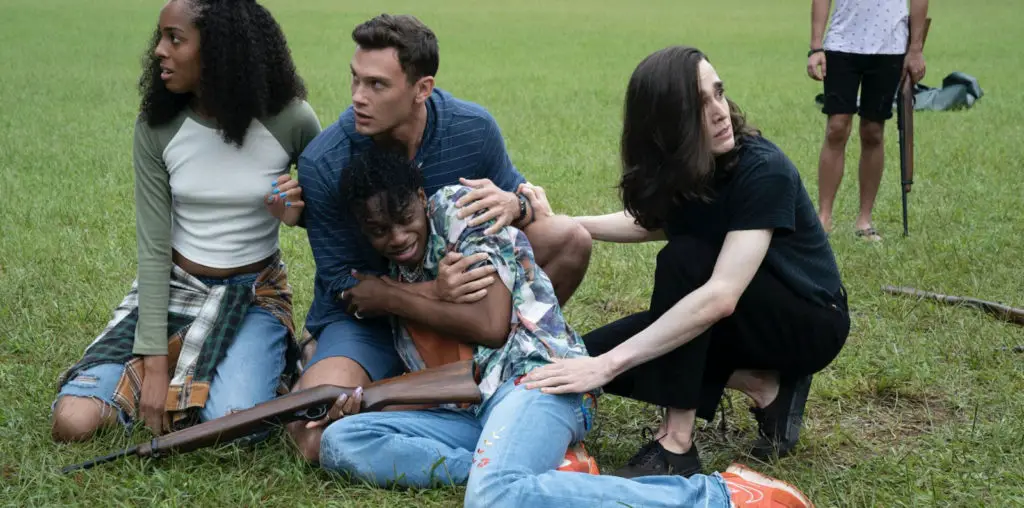
For some reason it has taken this long for a film maker to undertake the job of documenting the realm of super track motorcycle racing, specifically the Moto-GP world tour. But just because it hasn’t been done doesn’t mean anybody could do it properly. Writer/director Mark Neale is clearly a fan of this sport because he does it properly. He manages to find drama and interest in covering two seasons of the tour and he does a great job capturing it on the screen, shooting his race footage in digital.
Narrated by enthusiast Ewan McGregor we get introduced to the world of the Super Bikes, the 500cc 2-Stroke racing motorcycles, the pinnacle of the sport. “Faster” covers the 2001 and 2002 seasons on the tour which crosses the globe over 8 months. At the top of the hill are two Italian racers: Max Biagi, a flashy and popular face for the tour with corporate backing and movie star friends; and Valentino Rossi, a young newcomer who is a natural who has succeeded at every other level of racing. In short order these two develop a spiteful rivalry at the beginning of the 2001 season and their competitive nature provides the most compelling story, but it is not the only plot line. We also get to meet Gary McCoy, a new rider with a brash method that defies the conventions of racing styles, but his string of early victories turns heads. And then with injuries and technological problems the Red Bull team puts the call out to find the next big name in the sport, and the selection falls to a young American rider.
Director Neale clearly has an affection for the sport and takes the right course by not only turning his cameras on the stars themselves—the riders—but he incorporates most every aspect of the racing tour. Onscreen we see interviews with support staff, journalists, television personalities, and even the official doctor and team managers. Neal brings his work credibility by also speaking in depth with stars of past years on the Moto GP tour, the riders who brought advances in technology and speed. While each professional discloses intricacies into their own involvement all are uniform in their awe of what takes place on the track with these racers.
The photography brings to light how impressive the accomplishments of these riders are on the track. First consider they are racing at the same speed as the behemoths of NASCAR without the benefit of being surrounded by what is essentially a tank. A large amount of time is spent analyzing the accidents on the track, but that is not for the usual visceral thrill. Instead we come to see just how incredible it is that death is not a normal occurrence at these speeds. You can categorize the accidents into three types: The Slide, where the rear tire loses grip and the bike and rider drop to the surface together: The Flip, where the tire grabs hold the bike falls over to the other side of the turn. Normally these involve the least amount of injury and often the rider can get back on and finish the race. The worst is The Launch, when a rider pushes his ride the limit of physics and we see a common and frightful result, where the bike shakes briefly to correct itself and the rider invariably is propelled into the air.
The measure of this movie is not how it appeals to the biking set, because every button is pushed that would satisfy purists. But as a documentary for casual or non-fans it is highly entertaining. The photography alone would make this a worthwhile effort, but the drama that unfolds over the two years on tour is equally involving and framed by the interviews with former champions. As compelling as the Rossi/Biagi rivalry appears, it remarkably mirrors a similar rivalry between former riders Kevin Schwantz and Kenny Roberts ten years earlier. The stories are told by the participants and the visuals make them even more impressive.
“Faster” does the job. Motorcycle fans will surely drool and gape, but the rest should also walk away smiling. At the least if you are not a motorcycle racing fan you should come away impressed. At one point in the film the riders are compared to gods. After seeing how they perform on the track, how they survive wrecks without a roll cage, and how they manage to control a motorcycle that they need help climbing on before traveling 200 miles per hour—well, it is hard to reduce that description to hyperbole.
